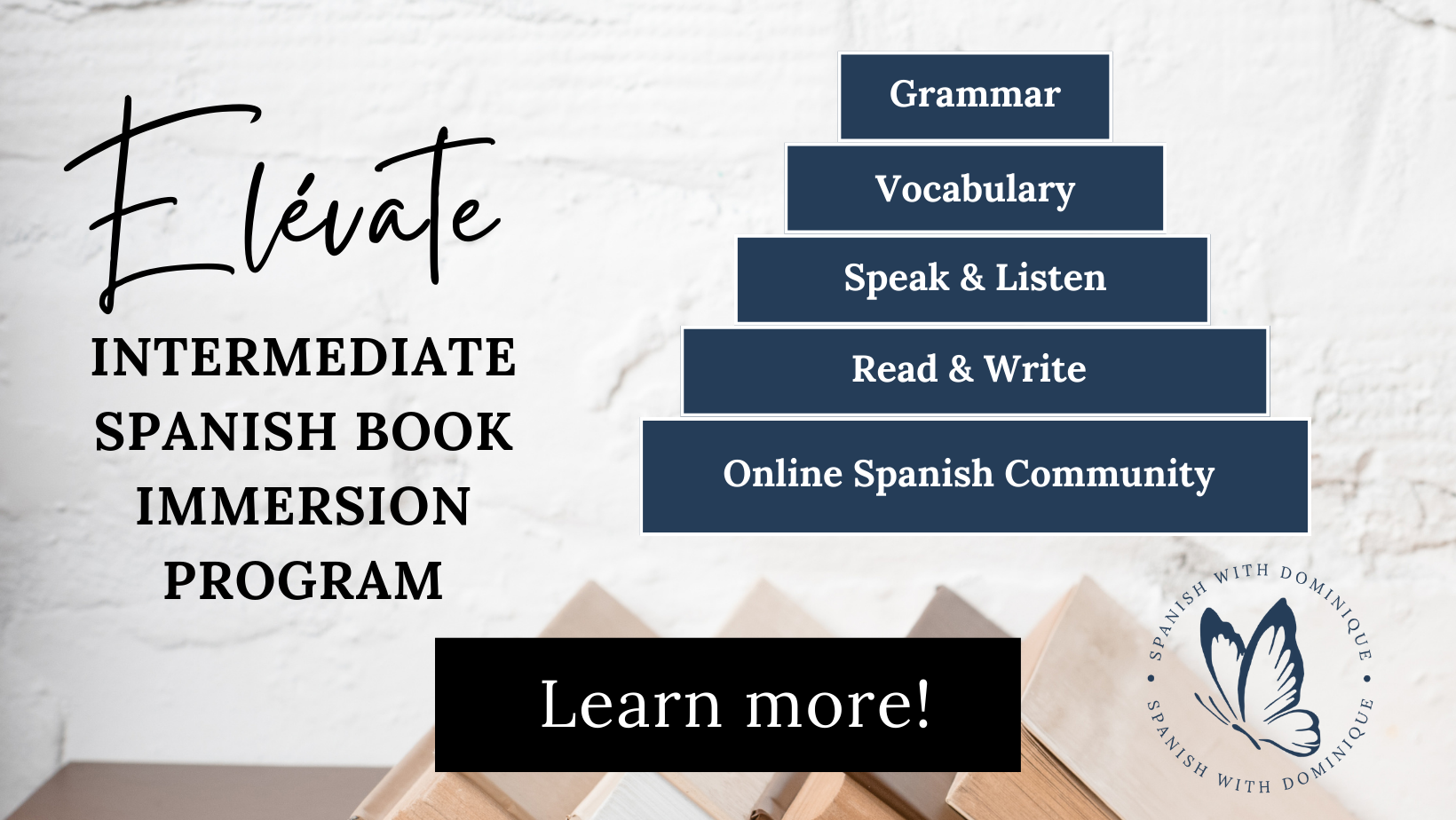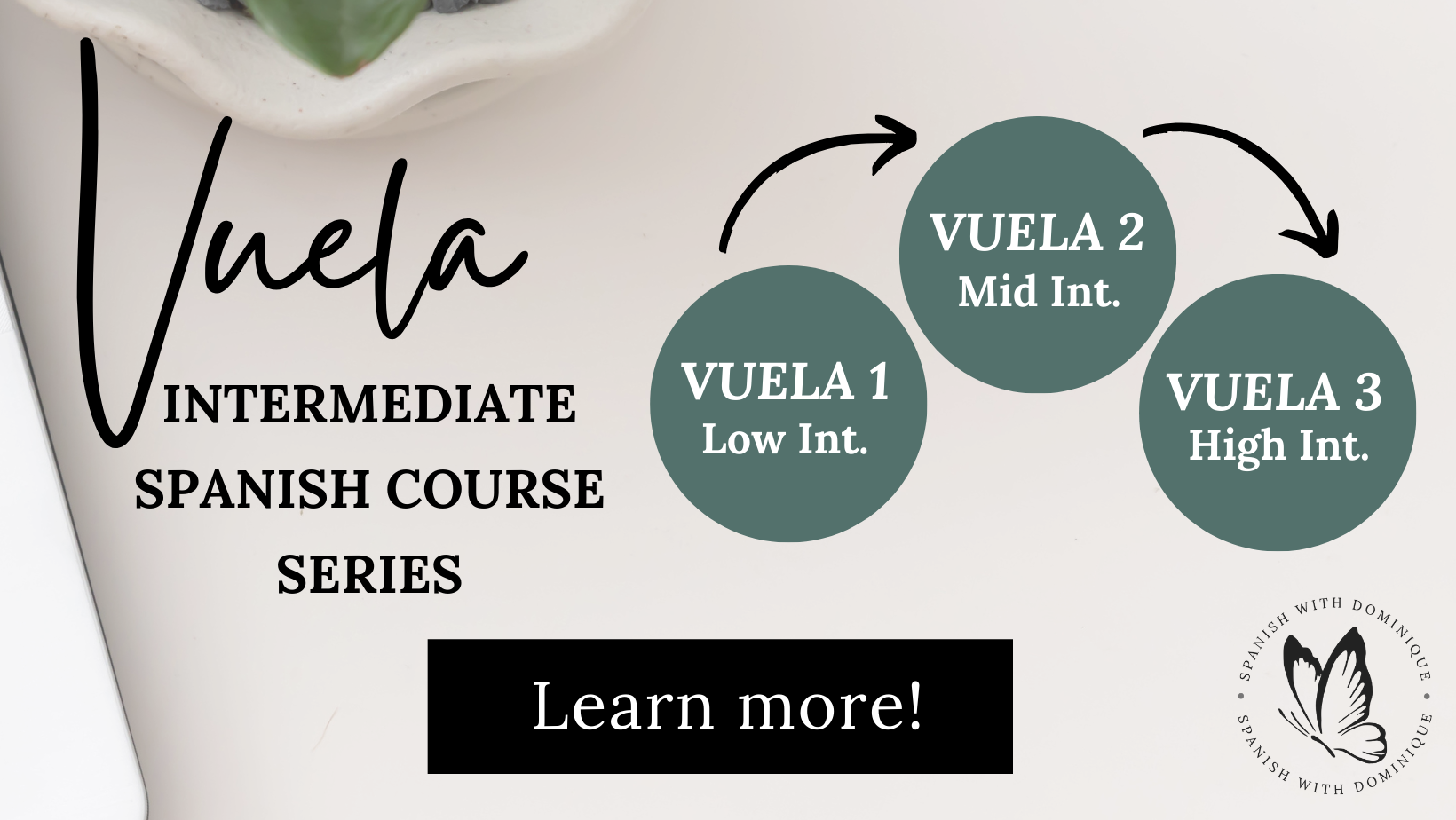The 6-Step Process to Reading Chapter Books in Spanish as an Adult Learner
In this post: Simple, easy 6-step process to read your first chapter book in Spanish and catapult your language skills.
Do you know the feeling of getting lost in a book you don’t want to put down? What if you could do that — but in Spanish?
I still remember the first Spanish chapter book I was able to read cover to cover while I was living in Barcelona. I still remember the magic of that realization of what it means to have reached this milestone of being able to read in Spanish.
If you’re like a lot of people I’ve worked with, you’ve tried reading chapter books in Spanish — only, for one reason or another, it didn’t go the way you’d hoped.
And that book is still sitting on your bookshelf — haunting you — while you wonder what you did wrong.
If you should have looked up more words or tried another reading technique?
If maybe you picked up the wrong book and what your should be reading instead?
In the end, so often, it’s those unanswered questions about reading in Spanish that stop you from developing this great new habit. Qué lástima…
Because here’s the truth: You’re probably closer than you think to being able to read chapter books in Spanish. You just need a good process to get you started.
Well, you’re in luck, my friend, because, in this post, I’ll be sharing 6 steps that will not only help you fall in love with reading in Spanish but also catapult your language skills.
Listo?
While reading this post, consider these questions:
Do you love to read in English? What would it be like to be able to be swept away by books in Spanish too?
What’s a book you’ve read and absolutely loved in English? Can you imagine re-reading it in Spanish?
If you’re a hesitant speaker in Spanish, what would it mean for you to be able to find confidence (and more fluency) through reading before ‘diving in’ to conversations in Spanish?
Before you begin, find the perfect Spanish book for you.
In the beginning, reading in Spanish as an adult was really difficult for me. [Can you relate?]
That’s because my well-intentioned teachers directed me to read really difficult, decades-old, Spanish literature (like Cien Años de Soledad or Don Quijote de La Mancha) way before I was ready. (Don’t worry, in 2025, you have your choice of Spanish books written just for beginners).
These books left me feeling defeated because I could barely read a few paragraphs before feeling completely lost.
What I realized later is that Spanish literature by world-renowned authors can often have really outdated language or just be too poetic for adult Spanish language learners.
[It’s like trying to learn English by reading Charles Dickens and Jane Austin. And then going out into the world and using English expressions from the 1800s.]
The truth is, as an intermediate Spanish learner, you need to be reading contemporary Spanish books written in thiscentury. Books that have clear, simple language, with relatable plot lines that interest you, and everyday expressions to help you develop practical vocabulary.
But where to find contemporary [and hopefully short!] Spanish books to read as an adult Spanish learner?
Well, that’s exactly why I created, The Spanish Learner’s Bookshelf, your go-to guide of 75+ contemporary Spanish book recommendations. This resource will save you time scouring Amazon for a good book so that you can jump right into building your Spanish skills through the 6-step process I’m going to lay out in this post.
And the best part? It has suggestions for every reading level. Like short 150-200 page books for low-intermediate learners who have just started reading longer books. All the way to marvelous 500+ page contemporary novels for those advanced-level students who are looking to challenge themselves. And everything in between.
That’s because there is an incredible power in connecting topics and hobbies that already interest you with what you read in Spanish. Reading about things that matter to you in your target language, really makes it stick.
Alright, now that you have some books to choose from, the next step is to learn how to read in a way that expands your language skills.
Here is my 6-step process to improve vocabulary, writing, and speaking skills through reading:
Step #1: Read through the chapter once to get the gist
When you’re first getting into reading chapter books in Spanish, keep your reading simple by taking things one chapter at a time.
Read through the chapter once without stopping to look up words. Your goal in the first read-through is simply to understand the main idea. It’s fine to underline words and phrases as you go to revisit later. But don’t break up your reading to look them up.
If you don’t understand a word, look for context clues in the sentence to see if you can figure out its meaning based on the other words around it.
Can you make a guess or prediction about what it might mean based on these clues?
Step #2: Look up 10 words and phrases
Once you’ve read through the chapter once, choose 10 words and phrases to look up. Yes, only 10!
If you get too carried away with this part, you could be looking up words for hours. This leads to overwhelm and makes us feel discouraged.
Selecting the most important words will help you add these words to your active memory so you can recognize them — and use them — later.
How will you know which ones to choose?
Read on for suggestions of top-priority words:
If you saw a word more than 5 times in the chapter that you didn’t know, look it up.
Write down the definition of the sentence example in your notebook. Or just scribble all over the margins as I do.
Don’t get too carried away with this part — remember, you’re focusing on just 10 words.
What other words should you look up?
Think of the words that really jumped out at you.
What does that mean exactly?
Well, they often look something like this:
words that struck you as interesting
words you wouldn’t have thought to use this way
words you’ve heard in conversation but never seen in writing
words you want to remember
or words you’ve never heard of before
Are you tempted to look up more than 10 words?
Remind yourself that with effective language learning, less is better.
Reading is a chance to train yourself to be flexible and be okay with not knowing the meaning of everything.
Remember, our brains in our native languages don’t actually understand everything, but as long as we understand the main idea, we learn more vocabulary every time we read.
Step #3: Read through the chapter, again
Now it’s time to take a final ‘victory’ lap around your chapter. You can read one more time and see for yourself how much better you understand now.
Just like in your native language, reading more than once is an essential way to build fluency, catch new details and find confidence in your reading — and in Spanish in general.
Step #4: Read through the English version
Reading a chapter — or an entire book in Spanish and English is sometimes referred to as bilingual reading or parallel reading.
This is a great way to get started reading in Spanish. Reading for the gist in Spanish and then making sure you’ve got the right idea by reading in English can be very reassuring. Remember, you learn from context by reading — but to learn from context, you actually have to understand it.
But re-reading your Spanish book chapter or in English can be great for even more experienced learners as well. In fact, I recommend parallel reading in my Elévate Book Immersion Program, which is designed for intermediate learners and above.
You can go beyond just checking to see if you’ve understood the main idea as you become more advanced with reading. You can discover details you missed and expressions you didn’t understand.
And as you become more advanced, you can even take note of how translators manage to depict cultural information or expressions that don’t exist in both Spanish and English.
Step #5: Read the chapter out loud
In fact, once you’ve taken the time to build up your reading fluency and confidence by re-reading this chapter, you don’t want to miss the opportunity to allow it to really sink in and build your speaking fluency.
Here’s what Judy from my** Elévate Book Immersion Program had to say about the experience of reading chapters aloud:
I read out loud frequently and often record myself and listen back. I read whatever story or article I'm working on. I think it helps my comprehension and my pronunciation. I often read so fast that I miss things I don't realize I missed. Reading out loud and then listening to myself catches those errors.
-Judi
Remember, you don’t have to start with a whole chapter. You can read a few sentences or paragraphs at a time to begin. Or a few sentences a day for a week.
Step #6: Write a 3-5 sentence chapter summary
Next, write a 3-5 sentence chapter summary in your notebook or in a Google Doc. Writing a chapter summary in Spanish in your own words is a powerful skill to develop and will help you learn to voice your thoughts.
When you’re first starting out, it's easiest to write a chapter summary in the present tense, like the events of the chapter are happening in real time.
For example, when recapping a chapter, instead of saying,
Francisco se juntó con unos amigos y se fueron a bailar. (Francisco got together with some friends, and they went dancing),
you could write,
Francisco se junta con unos amigos y se van a bailar. (Francisco gets together with some friends, and they go dancing).
By writing chapter summaries in the present tense, you focus more on the skill of summarizing rather than getting wrapped up in conjugations. Developing this skill will make you a better storyteller in Spanish.
Your key takeaways….
Reading in Spanish can be a magical milestone in your language-learning experience.
And if you love reading and are motivated to start, you are probably closer to being able to read books in Spanish than you realize.
I hope you’ll try out some or all of these suggestions I’ve created for you — they’re based on my own experience and that of many people I’ve read along with inside my Elévate Book Immersion Program. Before you know it, you’ll realize you can do this too.
And if you use these techniques for a while, I think you’ll be surprised at how much intentionally reading in Spanish can change the way you speak and communicate too.
When you start opening books in Spanish, you’ll open up new stories, cultures, and worlds to yourself. And you’ll open new possibilities for yourself as you learn Spanish as an adult as well.
I hope you let me know how it goes.
More Posts Handpicked Just For You!
Enjoyed this post? Here are some more you might like.






